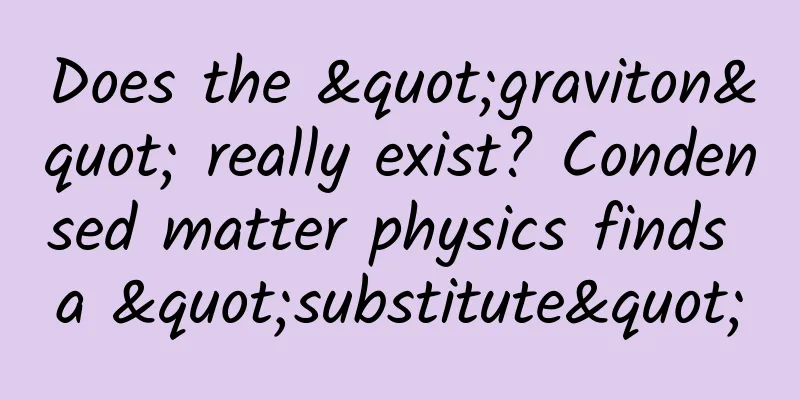Does the "graviton" really exist? Condensed matter physics finds a "substitute"

|
Author: Luo Huiqian, Researcher, Institute of Physics, Chinese Academy of Sciences Everyone has heard of universal gravitation and general relativity, and perhaps quantum mechanics. But do you know what a "graviton" is? Recently, a research team from Nanjing University announced the discovery of a "fractional quantum Hall effect graviton" (the study was published in Nature on March 28). So, what kind of particle is this graviton? What does the fractional quantum Hall effect mean? Today, let's talk about the "graviton" in condensed matter. Physicists always have a dream of "the unification of the world", hoping that the laws governing the operation of all things in the universe can be "minimalist mode", "simple" enough that perhaps only one equation is needed to describe it. But the problem is that general relativity is usually needed to describe the vast universe, while quantum physics is needed to describe microscopic particles. The time, space and energy scales involved in the two are N orders of magnitude different. This means that general relativity and quantum physics seem to be "completely unrelated", and it is extremely difficult to unify them. In 1939, the emergence of quantum gravity theory provided a feasible idea for grand unified physics. Its core idea is that there needs to be a particle called "graviton". What is a "graviton"? Let's simply compare it with electromagnetic interaction. We know that the interaction between electricity and magnetism is due to the existence of the electromagnetic field, and the disturbance of the electromagnetic field will emit electromagnetic waves. Light is a very common electromagnetic wave. Scientists have discovered that to describe electromagnetic interaction from the perspective of quantum physics, we only need to find the quantum that transmits energy and count it. The quantum of this electromagnetic wave is the "photon". Photons have a specific frequency, which represents the energy unit it has. Describing electromagnetic interaction is to count which energy units there are, how many there are, and where they go. Isn't it convenient? At the beginning of establishing the general theory of relativity, Einstein predicted the existence of gravitational waves. He believed that the gravitational field corresponds to the geometric structure of space-time. If a small stone is dropped into space-time, it will also cause "ripples" that spread outward like water waves. This is a gravitational wave. Quantum gravity theory tells us that just as the energy quantum of electromagnetic waves is a photon, the energy quantum of gravitational waves is a "graviton". The theory of gravitons seems perfect and is also the basis of other physical theories. For example, gravitons occupy a core position in the supermembrane theory, an upgraded version of superstring theory, and dark matter may be composed of massive gravitons. However, scientists have been searching for many years and have never observed any signs of "gravitons" in experiments. In contrast, gravitational waves were announced to have been discovered in early 2016 and soon won the Nobel Prize in Physics in 2017. There are many challenges in measuring gravitons, the main reason being that their energy is extremely low. Compared to the energy scales of black holes, neutron stars, and supernovae in the universe, the energy of gravitons is negligible. Detecting gravitons may be equivalent to stomping your feet on a distant planet, and measuring them on Earth is much more difficult than measuring gravitational waves. However, in addition to directly detecting the particles themselves, physicists have another solution, which is to find a "stand-in" for this particle. This trick was invented by a group of condensed matter physicists. The solid, liquid, glass, gel, etc. that make up matter are all called "condensed matter". There are a large number of microscopic particles in condensed matter, at least more than 1023 orders of magnitude. There are many interactions between these particles, of course, mainly electrical and magnetic interactions. Although we can write the equations of motion for each particle, there is no way to solve a set of equations above 1023. So, physicists constructed the concept of a "quasiparticle", that is, a large group of particles is simplified into a particle, which can be described by a simpler equation. Just like the idea of photons, to describe the complex interactions in solids, you only need to count the distribution of these quasiparticles. For example, the thermal vibration of atoms can transmit sound and heat, so the energy quantum is called a "phonon", which is the quantum of sound waves inside the material. The energy quantum that transmits the vibration of atomic magnetic moment is called "magnon", and there are also "Weyl fermions", "Dirac fermions", "Majorana fermions" and so on named after scientists. These particles are called so because they essentially satisfy the Weyl equations, Dirac equations and Majorana equations in the theory of elementary particles, at least in form there is no difference. At this point, you may have guessed that the various microscopic particles we usually talk about, whether known or unknown, can all be turned into "stand-ins" for the quasiparticles in condensed matter. Gravitons are no exception. About ten years ago, Nobel Prize winner Haldane proposed that there may be quasiparticle excitations similar to gravitons in the fractional quantum Hall effect, also known as "fractional quantum Hall effect gravitons." The so-called fractional quantum Hall effect is to confine a group of electrons in a two-dimensional space, such as between two semiconductors. Under the application of a strong magnetic field and extremely low temperatures, the Coulomb interaction between these collective electrons forms a series of new quantum states, and the corresponding quasiparticles no longer have the elementary charge as the smallest unit, but are fractionalized, such as one-third of the elementary charge. There are many forms of quasiparticles in this system, and Haldane believes that one of them is very similar to the "graviton" proposed in the theory of quantum gravity. To determine whether a quasiparticle is a "stand-in" for another particle, we need to "do a physical examination" on both of them, similar to checking height, weight, voiceprint, fingerprint, etc., and we can compare the mass, spin, charge, chirality, etc. of the two. Haldane's "fractional quantum Hall effect graviton" has the same characteristics as the graviton predicted by quantum gravity, such as spin 2 and chirality. The spin and chirality here refer to its intrinsic magnetic moment, just like self-rotation, and it has a specific direction, such as only conforming to the right-handed spiral rule. The "graviton" detected by the Nanjing University team was found in the gallium arsenide quantum well. This experimental challenge is very difficult. On the one hand, the temperature must be very close to absolute zero, 10 mK (i.e. -273.14°C) and the extremely strong magnetic field of 10 T to produce this effect; on the other hand, the measurement process requires the use of circularly polarized visible light, which inevitably encounters the problem of heat leakage from the transparent window; and, the energy of quasiparticles in the form of gravitons is extremely low (about 70 GHz), which is almost the limit of inelastic Raman scattering experiments. But this series of challenges was ultimately successful. Judging from various experimental evidences, they are very consistent with the "fractional quantum Hall effect graviton" predicted by Haldane. This shows that there is a lot of potential in condensed matter physics, and there are more interesting quasiparticles yet to be discovered. "Graviton" quasiparticle excitations in solids But it must be made clear that this "graviton" is strictly speaking a "geometric excited state" rather than a particle that can exist freely in the true sense. In other words, although they look very similar, if you check the "ID card code", you will find that the two are different. For example: the former is in two-dimensional space, and it is only an effect at the spatial scale, while the latter belongs to three-dimensional space, and is a quantized form of time + space (i.e. "space-time"). Moreover, the former needs to appear above a certain energy scale, while the latter belongs to extremely long-range interaction, because gravitational waves span the distant cosmic scale. Of course, this substitute for the "graviton" also has its own value. For example, we can simulate a rotating black hole with the help of a quasi-particle called a "polaron" in solids. Perhaps, we can also simulate those contents in quantum gravity theory that cannot be experimentally tested with the help of the "fractional quantum Hall effect graviton"? After all, the truth is simple, and the world is one. There are many basic principles of physics that are interconnected! This article is a work supported by Science Popularization China Starry Sky Project Author name: Luo Huiqian Reviewer: Zhang Shuangnan, Researcher, Institute of High Energy Physics, Chinese Academy of Sciences Produced by: China Association for Science and Technology Department of Science Popularization Producer: China Science and Technology Press Co., Ltd., Beijing Zhongke Xinghe Culture Media Co., Ltd. |
<<: The singer always goes to high E, why am I still busy trying to find the right pitch?
Recommend
2021 hot marketing calendar for the whole year! Hot spot analysis included
Whether you are doing new media operations, marke...
Artificial "Photosynthetic Miracle": How do "artificial leaves" reshape the future of energy and chemical industry?
Author Duan Yuechu In the billions of years of li...
A local self-media project that can earn at least 5,000+ per month just by accepting advertisements, come and learn about it
There are always some people who are busy working...
Mobile Photography Advanced Practical Video Course Baidu Cloud Download
By learning how to choose mobile phone devices, b...
Ignoring the failure of MEGA, Ideal will launch five more pure electric models next year, not only because of policy risks
In August 2024, Ideal Auto's delivery volume ...
The form of opening screen advertising!
Mobile advertising comes in many forms. For mobil...
Top 10 Essential Tools for WeChat Official Account Operations (Just Needed)
Recent articles are mainly about new media tools ...
5 steps for integrated marketing promotion across the entire network, this is the normal approach!
As the company develops and its market share incr...
How does Tik Tok grasp the best time for hot topics? How can I become popular on Tik Tok?
Many friends who are doing Douyin will encounter ...
21 ways to help you acquire effective users at low cost!
From the perspective of product operation , how t...
Product operation: overall operation framework ideas for content marketing!
Content marketing is divided into three aspects 1...
Three major differences between mobile and web conversion rates
For marketers, there are big differences between m...
Is the Newbie Financial Management Training Camp reliable? Is Xiaobaiying's financial management course real?
Is the Newbie Financial Management Training Camp ...









